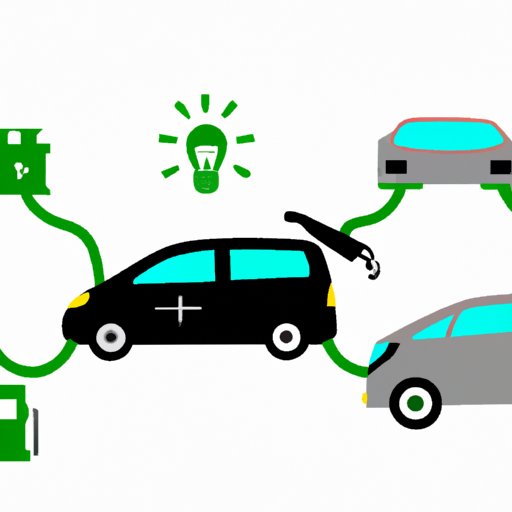Introduction
A hybrid vehicle is a car or truck powered by both an internal combustion engine and an electric motor. They offer a combination of greater fuel efficiency and lower emissions than traditional gasoline or diesel engines. Hybrids are becoming increasingly popular as people become more aware of the environmental benefits they offer. In this article, we will explore how a hybrid vehicle works and examine the benefits, cost considerations and environmental impact of owning one.

Explaining the Components of a Hybrid Vehicle and How They Work Together
A hybrid vehicle consists of four main components: an internal combustion engine, an electric motor, a battery pack and a transmission. The internal combustion engine is responsible for powering the vehicle and converting fuel into energy. The electric motor is used to supplement the power generated by the engine. The battery pack stores electricity generated by the engine and the motor and supplies it to the motor when required. Finally, the transmission controls the flow of power between the engine and the motor.
The internal combustion engine and electric motor work together in a hybrid vehicle to provide maximum efficiency. When the vehicle is in motion, the engine provides the majority of the power while the electric motor helps to supplement the power generated by the engine. During acceleration, the electric motor provides additional power to help the vehicle accelerate faster. When the vehicle is decelerating or stopped, the electric motor acts as a generator, recharging the battery.
Examining the Benefits of Owning a Hybrid Vehicle
Owning a hybrid vehicle comes with several benefits. The most obvious benefit is improved fuel economy. Hybrid vehicles are significantly more efficient than traditional gasoline or diesel engines, resulting in reduced fuel consumption and lower running costs. Additionally, hybrid vehicles tend to offer better performance than their counterparts, with quicker acceleration and higher top speeds.
Hybrids also produce fewer emissions than traditional fuel vehicles, making them a more environmentally friendly option. This is due to the fact that the electric motor produces zero emissions and the internal combustion engine runs more efficiently, resulting in fewer pollutants being released into the atmosphere.

Analyzing the Types of Hybrid Vehicles Available
There are three main types of hybrid vehicles available: full hybrids, mild hybrids, and plug-in hybrids. Full hybrids are the most common type of hybrid vehicle and are capable of running on either the electric motor or the internal combustion engine. Mild hybrids are similar to full hybrids but cannot run solely on the electric motor. Plug-in hybrids are capable of running on either the electric motor or the internal combustion engine, but they also have the ability to be plugged in to recharge the battery.
The type of hybrid vehicle you choose should depend on your individual needs and preferences. If you’re looking for a vehicle that has the best fuel economy and lowest emissions, then a full hybrid may be the best option. For those who don’t drive long distances, a mild hybrid may be a good choice since it doesn’t require plugging in. And if you need a vehicle that you can plug in to recharge the battery, then a plug-in hybrid may be the right choice.
Comparing the Cost of a Hybrid Vehicle to Traditional Fuel Vehicles
The initial cost of a hybrid vehicle is typically higher than that of a traditional fuel vehicle. However, there are several ways to offset this additional cost. For example, many governments offer tax incentives for purchasing a hybrid vehicle, and some insurance companies offer discounts for owners of hybrid vehicles. Additionally, the long-term savings from improved fuel economy and lower maintenance costs can make up for the initial cost difference.

Investigating the Environmental Impact of Hybrid Vehicles
Hybrid vehicles not only offer financial savings, but they also have a positive environmental impact. By switching to a hybrid vehicle, you can reduce your carbon emissions by up to 30%. Additionally, hybrid vehicles produce fewer pollutants than traditional fuel vehicles, resulting in less air and water pollution.
Conclusion
Hybrid vehicles offer a range of benefits, including reduced fuel consumption, improved performance and lower emissions. There are several types of hybrid vehicles available, so it’s important to consider your individual needs and preferences when selecting one. Although the initial cost of a hybrid vehicle may be higher than that of a traditional fuel vehicle, the long-term savings can more than make up for the difference. Finally, switching to a hybrid vehicle can significantly reduce your carbon emissions and pollution.
(Note: Is this article not meeting your expectations? Do you have knowledge or insights to share? Unlock new opportunities and expand your reach by joining our authors team. Click Registration to join us and share your expertise with our readers.)
